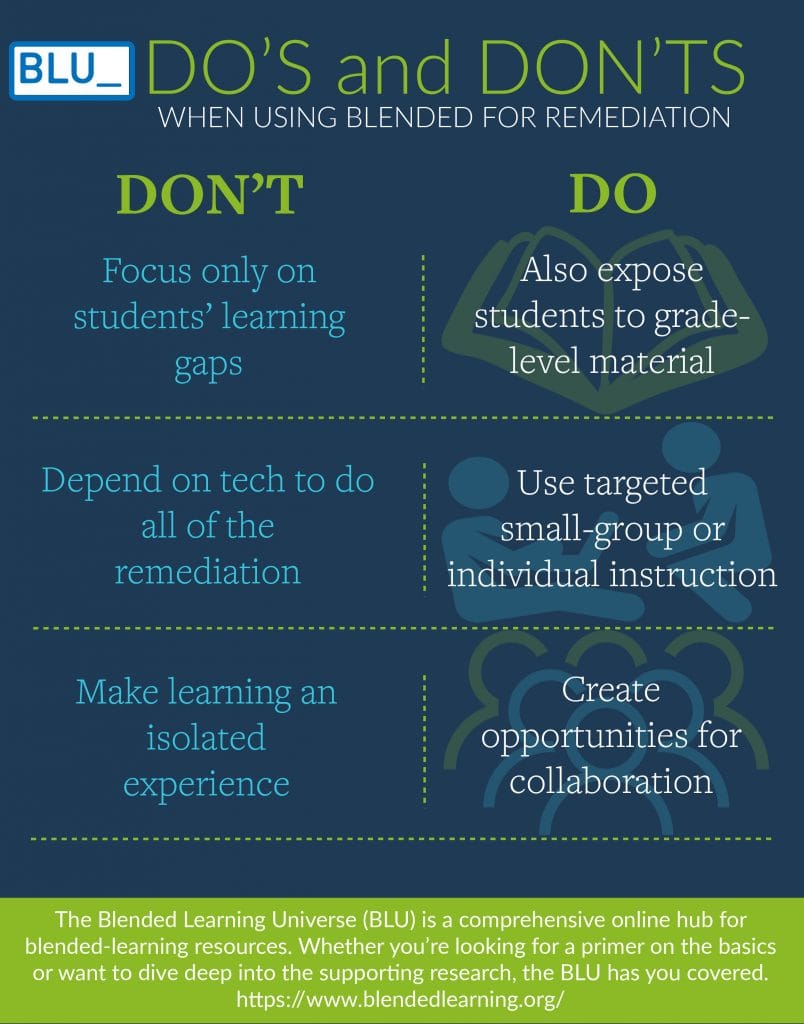The do’s and don’ts of blended teaching for remediation
August 29, 2018 |
August 29, 2018 |
Blended learning started in many cases by serving students in nontraditional settings (as disruptive innovations do), but we know that blended approaches have since grown, expanded, and evolved to serve millions of students in a variety of settings. Blended learning is now employed to meet a wide range of needs across student populations, and no two blended classrooms or experiences are identical. There are, however, commonalities that exist across schools, student populations, sectors, and nations as blended-learning practices adapt to meet specific needs.
Perhaps the most widespread need blended learning is used to meet is that of remediation. The average American student is not on grade level nor on track to be ready for college, which means that more than 50% of American students need some form of remediation in order to master the skills and content at their current grade level (see one study here). Of course, the promise of blended learning is that it can allow students to move at their own paces to master any skills they lack and therefore can provide individualized remediation (and maybe eventually, acceleration) for each student.
As the leader of blended-learning programs in a network of schools that support some of the nation’s most underserved students, I have witnessed the potential benefits of blended learning firsthand: many students have achieved nearly double their projected growth on norms-referenced assessments in a single year! I have also, however, seen a number of critical mistakes that cause students to flounder and fall further behind their peers instead of soaring ahead.
Based on these experiences, I created the following three “do’s” and “don’ts” for blended teaching and learning, particularly when it is used to help better serve the most vulnerable students.

1. Don’t focus only on filling students’ learning gaps; do expose students to grade-level material as well.
When teachers see that students have enormous gaps in their learning, it can be tempting to abandon grade-level standards entirely and focus only on remediating students’ learning gaps. Doing so, however, often results in lowered expectations and achievement gaps wider than they were before. Teachers need not lower the level of work they expect of their students simply because a student has not yet learned all of the prerequisite skills. Instead, teachers should ask what each student needs in order to master rigorous concepts and find a way to meet those needs.
This is a lofty charge, but it is far from impossible. The technology in a blended-learning model enables teachers to do exactly this by providing a wealth of information about the skills students still need to master, delivering instruction and practice to each student at his or her “just right” level, and freeing up the teacher to work with smaller groups of students.
2. Don’t depend on technology to do all of the remediation; do use targeted small-group or individual instruction to address students’ needs.
Having said that, teachers cannot rely solely on technology to remediate students’ gaps while focusing all of their own time on grade-level instruction. Adaptive software programs can go a long way in providing personalized instruction, but it would be a mistake to assume that technology can take care of all the remediation.
One of the greatest affordances of a blended-learning approach is the wealth of data teachers receive about the students’ strengths and areas of need. Teachers must use the data available to them to make strategic interventions that maximize learning. In some cases, this may take the form of a series of small-group lessons on a broad concept that is difficult for a number of students; in other cases, it could consist of a quick check-in with a single student to correct a small but important error. No matter the form it takes, though, it is crucial that teachers act upon the data available to them and do not rely too much on the technology.
3. Don’t make learning an isolated experience; do create opportunities for collaboration and group learning.
When teachers realize that students have such distinct needs, it can be tempting to completely individualize each student’s learning. This happens most often when teachers rely too much on technology, but it can also happen when teachers go above and beyond to design personalized-learning activities for each student. In the era of personalized learning in which the terms “average” and “whole-group” are demonized, it can be challenging to find a place for small-group and whole-group instruction and activities, but it is of the utmost importance.
We all know that rich learning happens in a community. For most students, the process of sense-making happens in an entirely new and exciting way when others are involved. In all learning experiences, it is imperative that students have peer-learning opportunities to contrast their thinking with each other, learn from one another, and construct answers together.
It might be overwhelming to think about all of the things teachers should not do in a blended classroom, so try flipping the way you view these guidelines. For teachers using blended learning to serve students with significant learning gaps, I recommend these best practices:
Keeping these three criteria at the front of mind will help ensure that blended learning is employed to give all students the educational experience they deserve.
Elizabeth Anthony leads blended-learning implementations in K–12 Catholic schools as the blended-learning coordinator for the Alliance for Catholic Education (ACE).
Leave a Reply